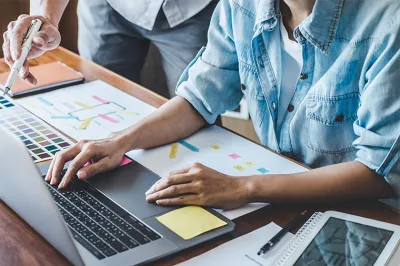Personalization is a business case

For: decision-makers, managers
Read Time: 5 minutes
Saturday morning, in your weekly routine, you step into the corner butcher shop. The butcher, in the back with a cleaver, welcomes you cheerfully. Are the kids okay? His memory and interest feel familiar. He sees you staring hesitantly at the display case of beef skewers. "Are you barbecuing?" Upon your confirmation, he suggests you also try the spicy chicken satay. New this week and a variation on last time. Gratefully you take his advice, pay for the skewers and the satay, and happily walk out of the store. Barbecue success guaranteed, a successful visit. The butcher in turn is satisfied: a pleasant contact, a good order and a satisfied customer. That's what he does it for.
Personal approach creates 10 to 30% added value
This is how we would like to treat all our customers; everyone would like such shopping experiences. Personal attention and up-to-date, relevant communication create measurable added value, while trust reinforces that value. We call the latter customer satisfaction, which can fluctuate over time.
So why do we so often not have that feeling online? The problem often lies in limitations. Butchers are limited, their memory is limited, their customer base is limited. Organizations with large customer groups run into problems of scale and switch to mass communication. At best, this is done "more or less segmented. The lack of time, central knowledge, resources and vision creates limitations.
That personalized approaches create the most value is now widely recognized. Research by McKinsey (2023) shows that personalization on a large scale can generate 10 to 30 percent additional sales and retention. Moreover, applying personalization can have long-term positive effects on customer satisfaction.
Technology is no longer an obstacle
So why aren't we applying personalization online everywhere yet? Until recently, the right tools were lacking. For decades, marketers tried to address their large customer and prospect bases more personally. That was often costly, time-consuming and error-prone. Poorly timed or irrelevant personalization could feel uncomfortable: using the wrong name, offering a vegetarian chicken satay or being endlessly pursued by an online ad.
Today, however, technology is no longer a limitation. Sending a customer an email that addresses them by name and offers a discount based on previous purchases is just the beginning. Thanks to modern automation platforms, AI and real-time data analytics, organizations can now deliver relevant, personalized communications on a large scale across multiple channels. This makes it possible to build lasting customer relationships and create value.
In addition, the right technology can create efficiencies: McKinsey indicates that organizations can gain 10 to 20 percent in marketing efficiency through automated personalization. At the same time, choosing the right platform and tactics is critical, as the number of marketing technology vendors will have grown to over 10,000 by 2025, depending on the niche.
Strategic choice
Do you want to provide more relevant customer experiences as an organization? Do you want to guide prospects to their next step? Understanding data and analytics is the key source of value. Personalization should be a priority, with the right capabilities and processes in place. It doesn't have to be a month-long project, but it does require a conscious strategic decision by management. In that sense, the butcher from the first paragraph is still an example: he chooses to keep his customer base happy and build it out.
Personalization is an approach, not a philosophy. It's about delivering meaningful, tailored communications that strengthen the relationship with each customer. That means involving not just marketing, but the entire organization, from CEO to operations team. With the right technology and a data-driven mindset, teams can test, learn and delight customers.
Overcoming Resistances
What's still holding organizations back from personalizing? Often it is a lack of understanding of available data or too big an idea of what is needed. Start small, activate data that is already available and get immediate results. This creates momentum and enthusiasm in the organization.
Another common problem is thinking in fixed campaign schedules. Triggers from customer behavior are more effective than fixed moments: messages can be valuable at any time.
In addition, personalization requires collaboration across departments. Teams that combine data, marketing, IT and operations can test and learn faster. Small successes scale up quickly and can increase impact by a factor of 2 to 5, depending on maturity and sector.
Costs remain a consideration. Lack of insight into customer value over time (CLV) can block investment. Still, it is essential to factor the long-term value of customer satisfaction into decisions.
Invest in A.I. or common sense?
Personalization plays a critical role in the full customer lifecycle: acquisition, engagement, cross-sell, retention and churn prevention. A complete customer data platform (CDP) with 360-degree-customer-view is useful, but start with basic information and learn right away. An initial model for personalized cross-selling can already yield significant results.
By analyzing customer behavior, you can identify key triggers and activate campaigns immediately. As more data becomes available, you can apply more complex methods such as Advanced Analytics, Machine Learning and Artificial Intelligence. These models continually learn and improve the precision of predictions.
Conclusion
Personalization can generate 10 to 30% additional revenue and 10 to 20% marketing efficiency, with additional effect on loyalty, retention and customer satisfaction - totaling 20 to 50% return. Technology enables scalable personalization, while investments in customer knowledge and management choices are key to success. Personalization is creating value by investing in insight, relationship and relevance for each customer.
Discover Ternair
Start personalization today
Personalization is creating value by investing in customer knowledge.
.



